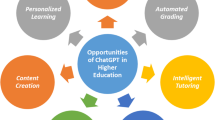Abstract
Educators who are prepared to make use of CSCL can find themselves restricted in their space for maneuvering regarding educational innovation. As a supportive context can be very important for them, the study presented here describes and analyzes a related case of a Community of Practice (CoP) among tutors contributing to the development and conduction of an educational in situ experiment. The paper describes the emergence of the CoP, its dissolving impact on limiting context factors and the empowerment of student participation in a MOO-mediated preparation of a Computer and Law seminar. It shows that a CoP among tutors can be beneficial for educational innovation and is a promising model to support the implementation of CSCL.
Similar content being viewed by others
References
Bourdieu, P., & Wacquant, L. (1992). Réponses. Pour une anthropologie reflexive. Editions du Seuil, Paris.
Brown, J. S., Denning, S., Groh, K., & Prusak, L. (2004). Storytelling in Organizations: Why Storytelling is Transforming 21st Century Organizations and Management. Boston, MA: Butterworth-Heinemann.
Brown, J. S., & Duguid, P. (1991). Organizational Learning and communities-of-practice: Toward a unified view of working, learning and innovation. Organization Science, 2(1), 40–57.
Bruckman, A. (1992). Identity Workshop: Social and Psychological Phenomena in Text-Based Virtual Reality. MIT, Cambridge, MA: unpublished paper, quoted in: Haynes and Holmevik 1998.
Bruckman, A., & Resnick, M. (1996). The MediaMOO Project, Constructionism and Professional Community. In Y. Kafai, & M. Resnick (Eds.) Constructionism in practice-designing, thinking, and learning in a digital world (pp. 207–222). N.J.: Mahwah.
Contu, A., & Willmott, H. (2003). Re-embedding situatedness: the importance of power relations in learning theory. Organization Science, 14(3), 283–296.
Enyedy, N., & Hoadley, C. M. (2006). From dialogue to monologue and back: Middle spaces in computer-mediated learning. International Journal of Computer-Supported Collaborative Learning, 1(4), 413–439.
Fischer, G., Rohde, M., & Wulf, V. (2007). Socio-cultural theories of learning. International Journal of Computer-Supported Collaborative Learning, 2(1), 9–40.
Goldstein, E. B. (1998). Sensation and Perception. Belmont, CA: Wadsworth.
Haynes, C., & Holmevik, J. R. (1998). Highwired. On the Design, Use, and Theory of Educational MOOs. Ann Arbor, MI: University of Michigan Press.
Hoadley, C. M. (1998). Between information and communication, middle spaces in computer media for learning.. In C. Hoadley, & J. Roschelle (Eds.) Proceedings of Computer Support for Collaborative Learning. Palo Alto California: Stanford University.
Holmevik, J. R., & Haynes, C. (2000). MOOniversity: A Student’s Guide to Online Learning Environments. Boston, MA: Allyn and Bacon.
Huysman, M., & Wulf, V. (2006). IT to support knowledge sharing in communities: Towards a social capital analysis. Journal of Information Technology, 21(1), 40–51.
Lave, J., & Wenger, E. (1991). Situated Learning: Legitimate Peripheral Participation. Cambridge, England: Cambridge University Press.
Nett, B. (2003). Identifying learning scenarios for a MOO in an academic learning context. In Proceedings of “e-Society 2003” (pp. 11–18). Lisbon, Portugal: IADIS Conference Press.
Nett, B. (2005). Measuring virtual student–student cooperation. A case study. The Journal of Educational Computing Research, 33(3), 269–284.
Orr, J. E. (1996). Talking about Machines. An Ethnography of a Modern Job. Ithaca, NY: Cornell University Press.
Osterlund, C., & Carlile, P. (2003). How Practice Matters: A Relational View of Knowledge Sharing. In M. Huysman, E. Wenger, & V. Wulf (Eds.) Communities and technologies (pp. 1–22). Dordrecht: Kluwer.
Rogoff, B., Matsuov, E., & White, C. (1998). Models of teaching and learning: Participation in a community of learners. In D.R. Olsen, & N. Torrance (Eds.) The handbook of education and human developments. New models of learning, teaching and schooling (pp. 338–414). Oxford, England: Blackwell.
Rohde, M., Stahl, G., & Wulf, V. (2007). Introduction to the special issue on computer support for learning communities. Behaviour & Information Technology, 26(1), 1–3.
Rosson, M. B., & Carroll, J. M. (2003). Learning and collaboration across generations in a community. In M. Huysman, E. Wenger, & V. Wulf (Eds.) Communities and technologies (pp. 203–226). Dordrecht: Kluwer.
Scarborough, H., & Swan, J. (2001). Knowledge communities and innovation. In M. Huysman and P. Van Baalen (Eds.), Trends in Communication, Special Issue on Communities of Practice (pp. 7–20).
Schinzel, B., Berszinski, S., Huber, B., Knirsch, S., Müller, A., Nett, B. et al. (2003). Ausgewählte Studien (selected studies), IIG-Berichte I/03, IIG, Freiburg im Breisgau.
Schulmeister, R. (1997). Grundlagen hypermedialer Lernsysteme: Theorie, Didaktik, Design, (Basics of hypermedia for e-learning. Theory, didactics, design) 2. Auflage, Oldenbourg, München, Wien.
Scott, J. C. (1990). Domination and the Arts of Resistance: Hidden Transcripts. New Haven, CT: Yale University Press.
Skinner, B. F. (1971). Beyond Freedom and Dignity. New York, NY: Knopf.
Star, S. L., & Griesemer, J. R. (1989). Institutional ecology, ‘translations’ and boundary objects: amateurs and professionals in Berkeley’s museum of vertebrate zoology, 1907 39. Social Studies of Science, 19, 387–420.
Stahl, G. (2006). Group cognition: Computer support for building collaborative knowledge. Cambridge, MA: MIT Press. Retrieved from: http://www.cis.drexel.edu/faculty/gerry/mit/.
Suchman, L. A. (1987). Plans and situated action. The problem of human-machine communication. Cambridge, MA: Cambridge University Press.
Veerman, A., & Veldhuis-Diermanse, E. (1999). Collaborative learning through computer-mediated communication in academic education. In Proceedings of CSCL 1999. University of Maastricht.
Wenger, E. (1998). Communities of practice—The social fabric of a learning organization. New York, NY: Cambridge University Press.
Wulf, V. (2000). Exploration environments: Supporting users to learn groupware functions. Interacting with Computers, 13(2), 265–299.
Author information
Authors and Affiliations
Corresponding author
Rights and permissions
About this article
Cite this article
Nett, B. A Community of Practice among tutors enabling student participation in a seminar preparation. Computer Supported Learning 3, 53–67 (2008). https://doi.org/10.1007/s11412-007-9031-3
Received:
Accepted:
Published:
Issue Date:
DOI: https://doi.org/10.1007/s11412-007-9031-3




